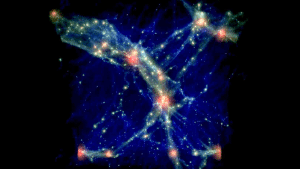Blog
A Question of Quasars
14 September 2014
 R. G. Clowes / UCLan, of the Huge-LQG
R. G. Clowes / UCLan, of the Huge-LQGQuasars are intense sources of radio energy that appear as almost starlike points. For this reason, when they were first discovered in 1939 they came to be known as quasi-stellar radio sources, or quasars for short. Early on it was not entirely clear what these objects were. They were incredibly energetic, and they also tended to have very large redshifts, which implied that they were very far away. It was also noticed that quasars weren’t randomly scattered across the sky, but instead tended to clump together in groups.
We now know that quasars are one example of what we call active galactic nuclei. They are powered by supermassive black holes in the centers of galaxies. This explains why they tend to be seen in groups. Since galaxies tend to clump into clusters and superclusters, their corresponding supermassive black holes are therefore also seen in clusters. Because of this, we can get a better understanding of how galaxies cluster across the universe by observing the distribution of quasars. Direct surveys of galaxies have been made out to about 6 billion light years, but quasars are so bright we can take that a bit further.
When we do studies of quasar clustering, we find a bit of a mystery. As a paper in MNRAS demonstrated, there are clustered structures of quasars that span more than 4 billion light years.1 Given big bang cosmology, and the presumption that the universe is homogeneous and isotropic, we wouldn’t expect clustering structures larger than about a billion light years across. Just how such huge quasar clusters could have formed is a mystery.
We have lots of evidence to support the big bang, so this mystery isn’t enough to overturn the big bang model, but it does show that there are still things we don’t understand about the cosmos. Things that span 4 billion light years apparently.2
Clowes, Roger G., et al. “A structure in the early Universe at z∼ 1.3 that exceeds the homogeneity scale of the RW concordance cosmology.” Monthly Notices of the Royal Astronomical Society 429.4 (2013): 2910-2916. ↩︎
For another view of this work, check out another post. ↩︎